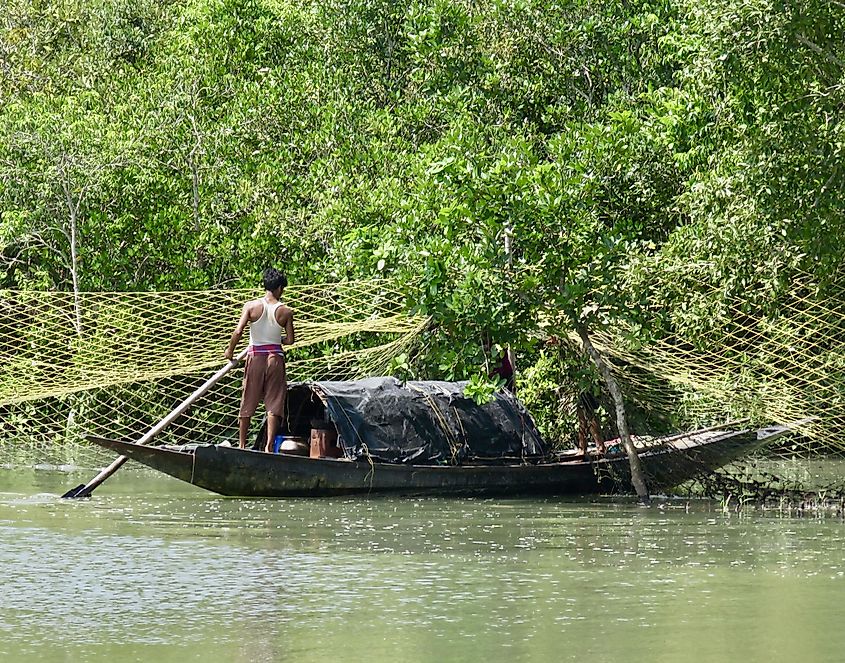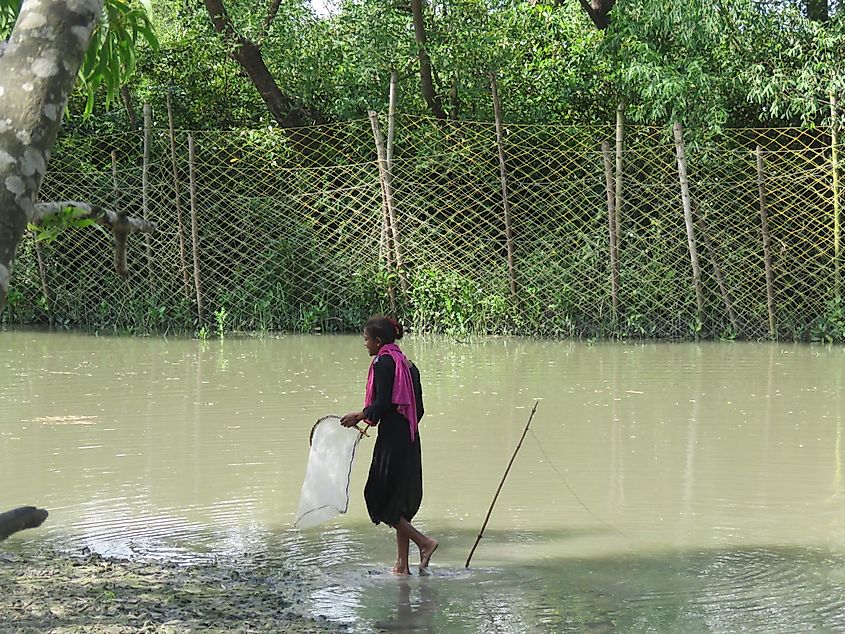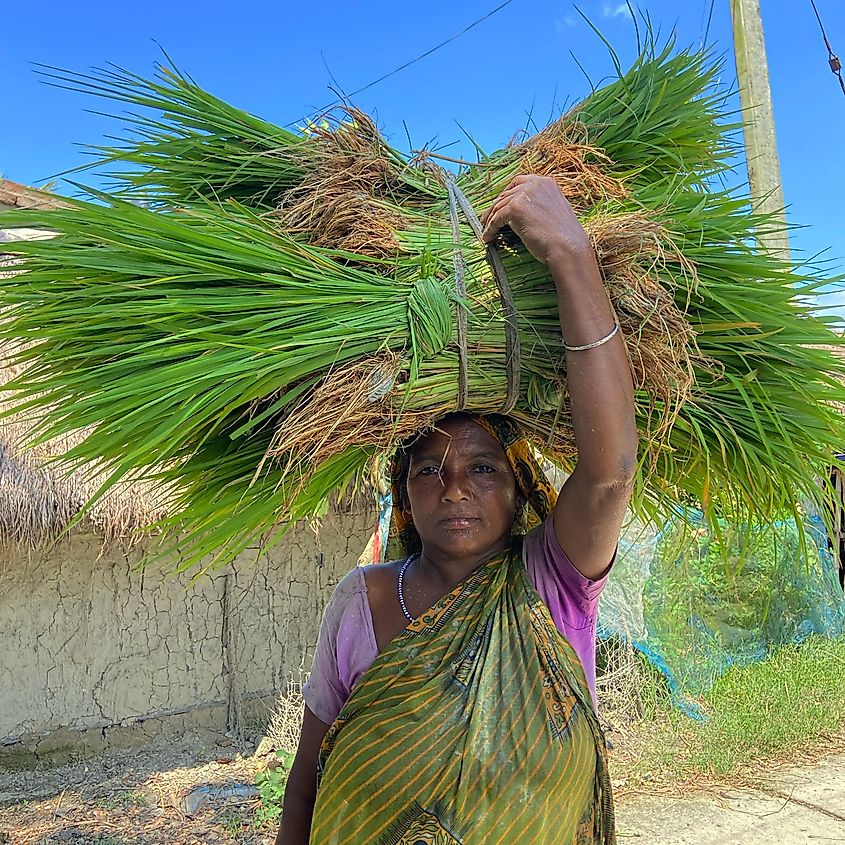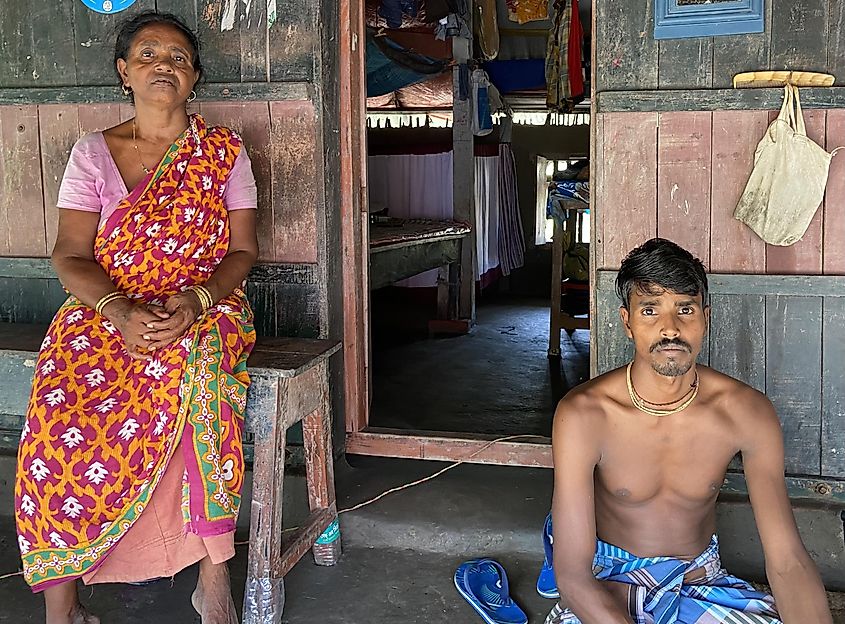
In India's Sundarbans: Where People Live Face-To-Face With Wild Tigers
Catching just a glimpse of the majestic apex predator of the world's largest mangrove forest is a dream of many wildlife enthusiasts from across the globe. But for the people living with the swamp tigers of the Sundarbans, India, such an encounter might mean a death sentence for them. Even in the 21st century, many villagers living in the numerous islands of the Sundarbans ecoregion become tiger prey as they tread into tiger territory, lured by the riches the mangrove forests have to offer. But for these people, this is just a way of life.
"The forest is the kingdom of the tiger. The tiger rules there. When we intrude into its territory, it attacks us. Isn't that normal?" said Kenoram Mistry, an aged resident of the Satjhelia island of the Sundarbans in India, as he displayed the scar on his left hand, left by the razor-sharp claws of a tiger that dug into his arm decades ago.
Sundarbans, a mangrove forest ecoregion at the Ganga-Brahmaputra river delta of India and Bangladesh, is truly a place where the primitive fears of humans come alive. Here, humans are a part of the food chain but not always the apex predator/consumer. Humans often serve as prey to the mighty Sundarbans tiger. But the human-tiger relationship in the UNESCO World Heritage Site of the Sundarbans is not limited to a predator-prey one. It runs very deep and is ever-evolving.
Into The Jaws Of Death

The story of the Sundarbans is a long and fascinating one. Numerous islands remain scattered in this delta region where the Ganga and Brahmaputra rivers meet the Bay of Bengal. Thick mangrove forests with trees adapted to survive the saltwater environment cover these islands. While humans have exerted their supremacy in some of these islands, others remain under tiger dominance.

In this unforgiving landscape where waves and winds constantly batter the coast to make life difficult for every inhabitant, a unique relationship has developed between the people and the tigers.
Tigers in the Sundarbans find hunting difficult. They have to cautiously tread through the thick slush dotted with jagged aerial roots of the mangrove trees in search of prey. They have to swim long distances in crocodile and shark-infested waters against strong currents searching for food, mate, and territory. Under such circumstances, an accidental meeting with Homo sapiens might mean bad news for the latter.

However, the heavy dependence of the people on the forest makes such encounters not too rare. The Sundarbans is famous for its crabs, fish, and honey that have high market value. With much of the forest area protected, the law allows the villagers to visit only permitted spaces for extracting honey, harvesting crab, and other fishing. But poverty and greed render such laws ineffective, as many still enter the prohibited forest areas for a better catch.

Bhobotosh Mondol, a middle-aged man, and his wife Alpana are among those who enter the forest to collect crabs for a living in the Indian Sundarbans. When asked what makes them take such extreme measures when life risk is involved, Bhobotosh said:
"I tried working outside the Sundarbans as manual labor. The work was hard, and I got little in return. It was not enough to sustain my family. So, I returned and decided that going into the forest near home is a better option for earning even though there is the danger of tiger or crocodile attacks," he said.
While the forest department sells permits every year to people looking to earn a living from the forest, the permits are expensive and are further restricted to certain zones. The result is a tiger haven that is highly protected, but also very rich and attractive to those willing to break the rules. Incidents involving illegal forest entries don't get recorded, and unfortunately, wildlife attack victims and their families are ineligible for compensation if they haven't adhered to the rules.

"Permits are very costly. We must share the cost and go out in large groups to the forest. That means sharing the profits as well, and we cannot afford that. We have to provide for our children and must earn enough to do so," said Gopal Gayen. He visits the forest with his wife Minati for crab harvesting even though he lost his father to a tiger attack in the past. Gopal and Minati have sworn not to allow their children to take up this dangerous activity.
Poverty is not the lone driving force behind this lethal profession of the people of the Sundarbans, according to Himanshu Mondal, a member of the Joint Forest Management Task Committee (JFMC) in the Indian Sundarbans.
"The problem is some people go to the forest due to need, but many go due to greed. Several families here earn well from alternative livelihood sources. However, the attraction of making more money in less time by going to the forest is too strong," he said.

As a member of the JFMC, Himanshu, a village resident of Satjhelia island of the Sundarbans, helps mitigate human-wildlife conflict issues in the region. The JFMC includes forest department staff and village representatives who work together for conservation in the Sundarbans. It acts as a communication bridge between the forest department and local communities.
Over the years, the forest department and NGOs working in the Sundarbans have tried to provide alternative income sources to the villagers to discourage them from going to the forest.
"We have introduced the villagers to poultry farming and aquaculture practices so that they can meet their domestic needs of protein and sell the excess to outsiders. We have also helped villagers set up vegetable gardens outside their homes to grow their own food. With the help of Indian Council of Agricultural Research (ICAR) and other organizations, we also train villagers to multiple crop farming using scientific methods. Tourism is also a major source of income for the locals here. The forest department employs educated local youth as tourist guides and a significant percentage of the revenue earned through tourism is also used in developmental activities. We are also promoting homestays in the villages here so that the tourism money directly goes to locals," said Anil Mistry, Principal Field Officer at Wildlife Protection Society of India (WPSI), an NGO that implements conservation programs to protect India's wildlife.

However, despite the efforts, many people in the Sundarbans continue to depend on the forest for their livelihood as evidenced by the large number of people who enter the forest to gather precious catch.
"Alternative sources of livelihood do exist, but the forest is like an ATM. The profit gained from selling crabs, fish, and honey from the forest is much higher and comes quicker than other ways of living. Also, the older generations are too lazy to start learning farming or new activities. For them, earning from the forest is easier even if the fear of death is always there," said Prashanta Mukherjee, a teacher from the nearby city of Kolkata, who is now a permanent resident of Sundarbans. He lives in a tribal village in Shamshernagar in India at the India-Bangladesh border and teaches the village children pro bono.
According to him, the younger generations are thinking differently. "The youth here are now ready to explore different options and not take up the hazard of going to the forest," he said.
The Guardian Angel

From the above, it appears that fear is the only emotion that the Sundarbans tigers evoke in humans with whom they share space. The truth is far from that, however.
"Yes, we must still save the tigers," replied Bhagirath Mondal when asked whether he supported tiger protection in the Sundarbans despite the high rate of prevalence of tiger attacks. 70-years old Bhagirath has seen many friends and family members killed by tigers in the forest over the decades.
"Imagine my home is unlocked and I am not there, then robbers will come and loot everything and leave. Similarly, if the tiger does not exist in the forest, the forest will disappear. People will cut down all trees and leave nothing since the fear of tigers would not exist. So, to keep the forest intact, tigers are needed. And we cannot survive without the forest," was his simple explanation.

"We are food for tigers. We catch crabs to eat, and tigers catch us to eat. So, why be angry at the tigers," Kuntala, a woman in her mid-30s, replied. She lost both her husband and her father-in-law to tigers as they went into the forest to collect crabs not too far from their home in Satjhelia Island. As a single mother of two, she has vowed never to enter the forest or allow her children to do so. She relies on a vegetable garden outside her home to put food on the table.
Even Asit Gayen, a young man living in the Kumirmari Island of the Sundarbans in India, echoes the same belief. Asit's father was a regular visitor to the forest and lost his life to the big cat early this year. "We persuaded him not to go, but he never listened to us. Going to the forest was like an addiction to him," lamented Asit as he sat by his aged, helpless mother.
When asked whether he is angry at the tiger who killed his father, he said: "No, no, we know that the forest exists because of the tiger, and we have also accepted the fact that we can die when entering the forest," he said.

Thus, the Sundarbans tigers are not just objects of fear but reverence as well. A couple of decades ago, however, the situation was vastly different.
"If you had come to these villages about 15 to 20 years back, you would have noticed how different it was at that time. The forest department and villagers were at loggerheads with each other. Every time a tiger would kill a person or enter a village, angry mobs would blame the forest department and even attack the tiger. I grew up witnessing many tigers put to death by the people," said Himanshu.
Indeed, it was not just the Sundarbans tiger. All wild tigers in India were at risk of extinction by the second half of the 20th century, after years of indiscriminate hunting fostered by the British Raj during the colonial era. The 1972 Wildlife Protection Act of India, however, came to the rescue. Tiger killing became illegal. The government of India also made immense efforts to recover tiger populations. Tigers became a matter of national pride in India as it was declared the national animal in 1972. Tiger numbers moved up from a mere 1,411 in 2006 to 2,976 in 2018. The tigers in the Sundarbans also benefitted under the umbrella of the new protection implemented to save the species. So did the tiger's habitat, the mangrove forests of the Sundarbans.

The forest department carried out mass awareness programs and implemented strict rules to prevent tiger killing in the Sundarbans. Forest areas were made off-limits to local people to stop the destruction of tiger habitat and poaching of tiger prey. Tiger territories were separated from villages with the help of nylon nettings. The government and NGOs also offered alternative sources of livelihood to the villagers to discourage them from entering tiger territory. The tiger now became a symbol of the future - the guardian of the Sundarbans mangrove forest.
An Unpredictable Future

Today, the Sundarbans is home to around 96 tigers in the Indian part and an estimated 114 tigers in Bangladesh. The region also supports over 4 million and 3 million people in India and Bangladesh, respectively. Protection by law and the implementation of conservation projects have helped mitigate human-wildlife conflicts in the region to a large extent. And people seem to have accepted tigers are the rightful owners of the forest.
However, all this might change again in the coming decades as Sundarbans is one of the world's most climatically vulnerable regions. With extreme weather events becoming more frequent, the Sundarbans has borne the brunt of severe cyclones in recent times.
"We now have cyclones almost twice every year. In the past, we used to have one in a decade. Water levels have also changed significantly," said Bhagirath with concern reflecting in his eyes.

As of now, such changes have only made the people more protective of the forest and its tigers, as explained by Himanshu: "The arrival of cyclones one after the other have made the local communities here aware of the fact that they cannot survive without the forest. Places with thick mangrove forest cover along the coast have suffered lesser damage than others. So, people now are even more ready to join forces with the forest department to protect the mangroves and its tigers. They even fight each other to stop deforestation. For example, if someone lets their goats graze in the forest, another person will scold him as grazing activities deplete forest cover," he said.
However, this tolerance might not last long. Scientists predict that climate change will displace and kill people and wildlife living in vulnerable areas like the Sundarbans and have far-ranging effects on such landscapes and ecosystems in the future. Only time will tell how the relationship between the swamp tigers and the people will evolve in the next few decades. And the world's reaction to climate change will determine the future of this unique relationship.
Cover Image: By Samik Dutta
Acknowledgments: Lt. Col. Shakti Ranjan Banerjee, Honorary Director, Wildlife Protection Society of India; Nilanjan Roy Chowdhury, Secretary, Anubhab, Kolkata











